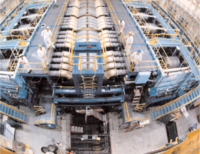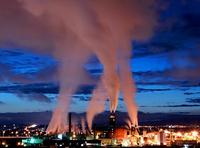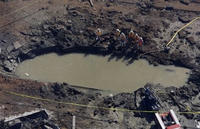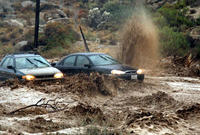-
U.S. releases smart grid cybersecurity strategy
Last week the U.S. Department of Energy released its strategic framework for its plan to install and secure the nation’s electrical grid system over the next decade; the report outlines a plan to coordinate efforts by the government and the private sector to begin designing and implementing an electrical grid that is capable of withstanding a cyberattack
-
-
Michigan creates cyber and physical infrastructure protection department
The state of Michigan is now merging responsibility for both physical and digital infrastructure protection under one organization
-
-
New rail-sensing technology saves time, energy, money
Leaves, as well as snow and rain, cause problems for trains because they reduce traction and cause wheels to spin on acceleration or to lock when slowing down; researchers are working to solve the age-old problem of leaves on the line delaying trains
-
-
Building codes may underestimate multiple hazard risks
Current building codes consider natural hazards individually — if earthquakes rank as the top threat in a particular area, local codes require buildings to withstand a specified seismic load; if hurricanes or tornadoes are the chief hazard, homes and buildings must be designed to resist loads up to an established maximum wind speed; engineers say that building codes should address multiple hazard scenarios
-
-
Two radiation generators help protect U.S.

One aspect of a nuclear explosion— the electro-magnetic pulse, or EMP — was much discussed during the cold war: scientists argued that exploding a nuclear bomb in the skies high above the United States would create an EMP which would disrupt electronic equipment and paralyze the nation; two remarkable pulsed-power machines used to test the U.S. defenses against atomic weapons have surpassed milestones at Sandia National Laboratories
-
-
Industrial stent-like repairs for failing pipelines
There are thousands of miles of pipe underground in the United States, some more than 100 years old; gas, oil, water, and sewage seep, and sometimes gush, through corroded joints and defective welds every day; new technology uses carbon and glass laminates to repair and replace failing pipelines
-
-
Sea level rise to take economic toll on California coast
California beach towns could face hefty economic losses caused by sea level rise, according to a new state-commissioned study; the study estimates the cost of coastal storm damage and erosion, both of which are expected to increase as sea levels rise
-
-
Decade after 9/11, infrastructure interdependence a major problem for U.S.
After years of study of the impact on infrastructure of the 9/11 attacks, a groups of experts paints a disconcerting picture of major infrastructure systems that were highly dependent upon one another; even today, these experts see this deep interdependency as a liability and threat to national security and the quality of life for its citizens
-
-
Earthquake prediction, a holy grail of science
Predicting earthquakes has proven to be an elusive pursuit for scientist and the mainstream consensus is that it will never happen, but one group remains hopeful; unlike the majority of geologists, who now believe it is nearly impossible to accurately predict earthquakes, those still searching for solutions tend to work in physics and atmospheric science
-
-
AI helps identify leaky pipes, prevent flooding
Engineers have pioneered new methods for detecting leaky pipes and identifying flood risks with technologies normally used for computer game graphics and Artificial Intelligence; these techniques could help to identify water supply and flooding problems more quickly than ever before
-
-
Studying the effects of fire on steel structures, nuclear plants
Building fires may reach temperatures of 1,000 degrees Celsius, or more than 1,800 degrees Fahrenheit, and the strength of steel structures drops by about 40 percent when exposed to temperatures exceeding 500 degrees Celsius; scientists study precisely what happens to the connections between a floor’s steel beams and the building columns when these connections are exposed to intense heat
-
-
Cutting soot emissions fastest, cheapest way to slow warming
Reducing soot emissions from diesel engines and other sources could slow melting of sea ice in the Arctic faster and more economically than any other quick fix; the good news is that decreasing soot could have a rapid effect — unlike carbon dioxide, which remains in the atmosphere for years, soot disappears within a few weeks, so that there is no long-term reservoir with a continuing warming effect
-
-
Artificial volcanoes to reverse global warming

British scientists are investigating a method to reverse the effects of climate change by creating an artificial volcano and suspending it 12.5 miles above the earth; the team’s goal is to recreate the cooling effect that a volcano has when it releases millions of tiny particles into the stratosphere that bounce some of the Sun’s rays back into space
-
-
Report finds poor management cause of San Bruno natural gas explosion

An investigation into the cause of a natural gas pipeline explosion that killed eight people and destroyed dozens of homes in San Bruno, California, placed the blame squarely on fifty-four years of bad management by Pacific Gas & Electric Company (PG&E) and the failure of state and federal regulators to notice the problem
-
-
Automated flash-flood phone alert system developed

A part of Texas is called Flash Flood Alley because of the frequency and ferocity of flash floods; it stretches from San Antonio through Austin and to Dallas, and includes the Fort Hood military base; researchers develop a system which uses cell phones to give real-time text alerts of flash floods in the area
-
More headlines
The long view
Helping Strengthen America’s Critical Infrastructure
Everyday life depends on a robust infrastructure network that provides access to running water, communications technology and electricity, among other basic necessities. The experts who keep our national infrastructure secure and resilient also need a strong network to share their knowledge and train the next generation of professionals capable of solving complex infrastructure challenges.
AI and the Future of the U.S. Electric Grid
Despite its age, the U.S. electric grid remains one of the great workhorses of modern life. Whether it can maintain that performance over the next few years may determine how well the U.S. competes in an AI-driven world.
